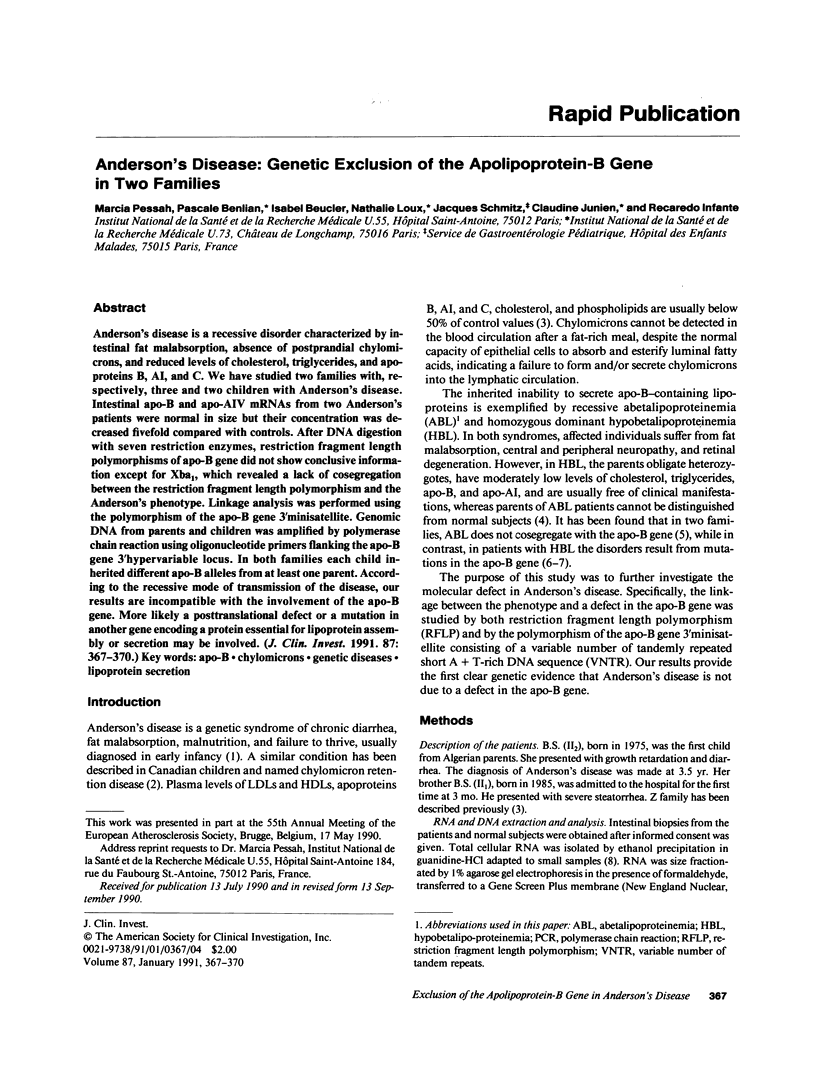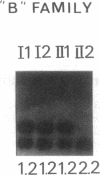Abstract
Anderson's disease is a recessive disorder characterized by intestinal fat malabsorption, absence of postprandial chylomicrons, and reduced levels of cholesterol, triglycerides, and apoproteins B, AI, and C. We have studied two families with, respectively, three and two children with Anderson's disease. Intestinal apo-B and apo-AIV mRNAs from two Anderson's patients were normal in size but their concentration was decreased fivefold compared with controls. After DNA digestion with seven restriction enzymes, restriction fragment length polymorphisms of apo-B gene did not show conclusive information except for Xba1, which revealed a lack of cosegregation between the restriction fragment length polymorphism and the Anderson's phenotype. Linkage analysis was performed using the polymorphism of the apo-B gene 3'minisatellite. Genomic DNA from parents and children was amplified by polymerase chain reaction using oligonucleotide primers flanking the apo-B gene 3'hypervariable locus. In both families each child inherited different apo-B alleles from at least one parent. According to the recessive mode of transmission of the disease, our results are incompatible with the involvement of the apo-B gene. More likely a posttranslational defect or a mutation in another gene encoding a protein essential for lipoprotein assembly or secretion may be involved.
Full text
PDF



Images in this article
Selected References
These references are in PubMed. This may not be the complete list of references from this article.
- ANDERSON C. M., TOWNLEY R. R., FREEMANM, JOHANSEN P. Unusual causes of steatorrhoea in infancy and childhood. Med J Aust. 1961 Oct 14;48(2):617–622. doi: 10.5694/j.1326-5377.1961.tb69860.x. [DOI] [PubMed] [Google Scholar]
- Bell-Quint J., Forte T., Graham P. Glycosylation of apolipoproteins by cultured rat hepatocytes. Effect of tunicamycin on lipoprotein secretion. Biochem J. 1981 Nov 15;200(2):409–414. doi: 10.1042/bj2000409. [DOI] [PMC free article] [PubMed] [Google Scholar]
- Benlian P., Bonaiti C., Douste-Blazy P., Junien C. Candidate gene approach to type IIa hypercholesterolaemia. Lancet. 1989 May 27;1(8648):1201–1202. doi: 10.1016/s0140-6736(89)92778-5. [DOI] [PubMed] [Google Scholar]
- Biemer J. J., McCammon R. E. The genetic relationship of abetalipoproteinemia and hypobetalipoproteinemia: a report of the occurence of both diseases within the same family. J Lab Clin Med. 1975 Apr;85(4):556–565. [PubMed] [Google Scholar]
- Boerwinkle E., Xiong W. J., Fourest E., Chan L. Rapid typing of tandemly repeated hypervariable loci by the polymerase chain reaction: application to the apolipoprotein B 3' hypervariable region. Proc Natl Acad Sci U S A. 1989 Jan;86(1):212–216. doi: 10.1073/pnas.86.1.212. [DOI] [PMC free article] [PubMed] [Google Scholar]
- Bouma M. E., Beucler I., Aggerbeck L. P., Infante R., Schmitz J. Hypobetalipoproteinemia with accumulation of an apoprotein B-like protein in intestinal cells. Immunoenzymatic and biochemical characterization of seven cases of Anderson's disease. J Clin Invest. 1986 Aug;78(2):398–410. doi: 10.1172/JCI112590. [DOI] [PMC free article] [PubMed] [Google Scholar]
- Bouma M. E., Beucler I., Pessah M., Heinzmann C., Lusis A. J., Naim H. Y., Ducastelle T., Leluyer B., Schmitz J., Infante R. Description of two different patients with abetalipoproteinemia: synthesis of a normal-sized apolipoprotein B-48 in intestinal organ culture. J Lipid Res. 1990 Jan;31(1):1–15. [PubMed] [Google Scholar]
- Collins D. R., Knott T. J., Pease R. J., Powell L. M., Wallis S. C., Robertson S., Pullinger C. R., Milne R. W., Marcel Y. L., Humphries S. E. Truncated variants of apolipoprotein B cause hypobetalipoproteinaemia. Nucleic Acids Res. 1988 Sep 12;16(17):8361–8375. doi: 10.1093/nar/16.17.8361. [DOI] [PMC free article] [PubMed] [Google Scholar]
- Gunning P., Ponte P., Okayama H., Engel J., Blau H., Kedes L. Isolation and characterization of full-length cDNA clones for human alpha-, beta-, and gamma-actin mRNAs: skeletal but not cytoplasmic actins have an amino-terminal cysteine that is subsequently removed. Mol Cell Biol. 1983 May;3(5):787–795. doi: 10.1128/mcb.3.5.787. [DOI] [PMC free article] [PubMed] [Google Scholar]
- Jenner K., Sidoli A., Ball M., Rodriguez J. R., Pagani F., Giudici G., Vergani C., Mann J., Baralle F. E., Shoulders C. C. Characterization of genetic markers in the 3' end of the apo B gene and their use in family and population studies. Atherosclerosis. 1988 Jan;69(1):39–49. doi: 10.1016/0021-9150(88)90287-0. [DOI] [PubMed] [Google Scholar]
- Knott T. J., Pease R. J., Powell L. M., Wallis S. C., Rall S. C., Jr, Innerarity T. L., Blackhart B., Taylor W. H., Marcel Y., Milne R. Complete protein sequence and identification of structural domains of human apolipoprotein B. Nature. 1986 Oct 23;323(6090):734–738. doi: 10.1038/323734a0. [DOI] [PubMed] [Google Scholar]
- Lackner K. J., Monge J. C., Gregg R. E., Hoeg J. M., Triche T. J., Law S. W., Brewer H. B., Jr Analysis of the apolipoprotein B gene and messenger ribonucleic acid in abetalipoproteinemia. J Clin Invest. 1986 Dec;78(6):1707–1712. doi: 10.1172/JCI112766. [DOI] [PMC free article] [PubMed] [Google Scholar]
- Leppert M., Breslow J. L., Wu L., Hasstedt S., O'Connell P., Lathrop M., Williams R. R., White R., Lalouel J. M. Inference of a molecular defect of apolipoprotein B in hypobetalipoproteinemia by linkage analysis in a large kindred. J Clin Invest. 1988 Sep;82(3):847–851. doi: 10.1172/JCI113688. [DOI] [PMC free article] [PubMed] [Google Scholar]
- Levy E., Marcel Y., Deckelbaum R. J., Milne R., Lepage G., Seidman E., Bendayan M., Roy C. C. Intestinal apoB synthesis, lipids, and lipoproteins in chylomicron retention disease. J Lipid Res. 1987 Nov;28(11):1263–1274. [PubMed] [Google Scholar]
- Ludwig E. H., Friedl W., McCarthy B. J. High-resolution analysis of a hypervariable region in the human apolipoprotein B gene. Am J Hum Genet. 1989 Sep;45(3):458–464. [PMC free article] [PubMed] [Google Scholar]
- Mehrabian M., Schumaker V. N., Fareed G. C., West R., Johnson D. F., Kirchgessner T., Lin H. C., Wang X. B., Ma Y. H., Mendiaz E. Human apolipoprotein B: identification of cDNA clones and characterization of mRNA. Nucleic Acids Res. 1985 Oct 11;13(19):6937–6953. doi: 10.1093/nar/13.19.6937. [DOI] [PMC free article] [PubMed] [Google Scholar]
- Munnich A., Daegelen D., Besmond C., Marie J., Dreyfus J. C., Kahn A. Cell-free translation of messenger RNAs from human muscle biopsies: a miniaturized tool for investigation of neuromuscular diseases. Pediatr Res. 1982 May;16(5):335–339. doi: 10.1203/00006450-198205000-00001. [DOI] [PubMed] [Google Scholar]
- Roy C. C., Levy E., Green P. H., Sniderman A., Letarte J., Buts J. P., Orquin J., Brochu P., Weber A. M., Morin C. L. Malabsorption, hypocholesterolemia, and fat-filled enterocytes with increased intestinal apoprotein B. Chylomicron retention disease. Gastroenterology. 1987 Feb;92(2):390–399. doi: 10.1016/0016-5085(87)90133-8. [DOI] [PubMed] [Google Scholar]
- Siuta-Mangano P., Janero D. R., Lane M. D. Association and assembly of triglyceride and phospholipid with glycosylated and unglycosylated apoproteins of very low density lipoprotein in the intact liver cell. J Biol Chem. 1982 Oct 10;257(19):11463–11467. [PubMed] [Google Scholar]
- Soria L. F., Ludwig E. H., Clarke H. R., Vega G. L., Grundy S. M., McCarthy B. J. Association between a specific apolipoprotein B mutation and familial defective apolipoprotein B-100. Proc Natl Acad Sci U S A. 1989 Jan;86(2):587–591. doi: 10.1073/pnas.86.2.587. [DOI] [PMC free article] [PubMed] [Google Scholar]
- Talmud P. J., Lloyd J. K., Muller D. P., Collins D. R., Scott J., Humphries S. Genetic evidence from two families that the apolipoprotein B gene is not involved in abetalipoproteinemia. J Clin Invest. 1988 Nov;82(5):1803–1806. doi: 10.1172/JCI113795. [DOI] [PMC free article] [PubMed] [Google Scholar]






